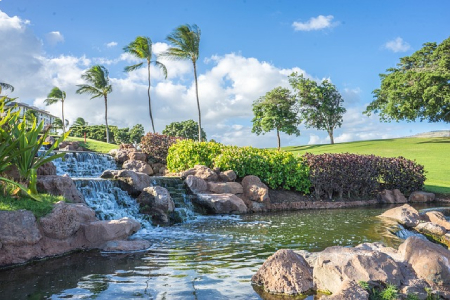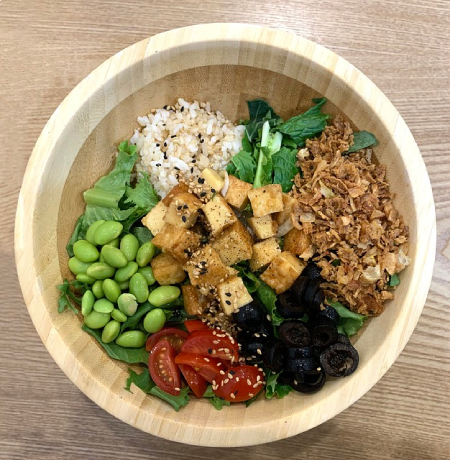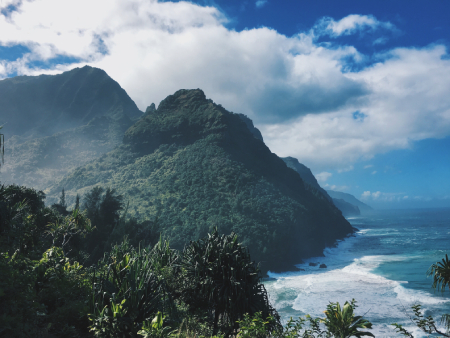The Spirit of Aloha

Photo: Waterfall in Oahu, Hawaii - Photo Credit: Michelle Maria - Pixabay
You might be familiar with the Hawaiian custom of greeting guests with a lei, a floral wreath worn around the neck. But it’s more than just a decorative welcome. It’s a symbol of the people’s affections and generosity. This is not the only tradition that has endured Hawaii’s rich and fraught history—from Polynesian migration around 500 A.D. to the infamous arrival of Captain James Cook in 1778 to U.S. statehood in 1959, Hawaiians have worked to preserve the traditions that unite the seven inhabited islands that occupy one of the most geographically isolated places on the planet.
Storytelling through Song & Dance
The image of a hula dancer in a grass skirt swaying her hands and hips while chanting mele is the ubiquitous symbol of Hawaiian culture, and for good reason. The ancient dance has religious roots; it was once a male-only spiritual dance that has come to be performed by anyone seeking a moment of joy. Over the years, Hawaiians have worked to preserve the native dance, referred to by many as the “heartbeat of Hawaii.” It’s now performed at luaus and taught in dance schools for residents and tourists alike.
Rather than simply observe, today’s travellers want an immersive experience, and many hotels have taken note. The Four Seasons Lanai, for example, offers ukulele, lei-making and hula lessons for guests of all ages. And to honor Hawaiians’ respect for their elders, a tradition likely reflecting the considerable Asian influence throughout the islands, the Four Seasons’ complimentary “Hoopika” (meaning “hospitality”) cultural program offers insights into the knowledge of the revered elders with interactive lessons on “oral history, age-old customs and traditional art.”
Fire knife dancing is another tradition that won’t be extinguished soon. The ancient Samoan war dance, used to boost warriors’ morale before battle, is one better observed than attempted. Lucky for us, luaus still feature the mesmerizing dance that often combines acrobatic feats with machete-tossing mastery. Study the best fire twirlers in the world every May at the annual World Fireknife Championship at the Polynesian Cultural Center in Honolulu—it’s no surprise that a native Hawaiian usually wins.

Photo: Vegetarian Poke Bowl - Photo Credit: Pixabay
Spam, Poke & Mai Tais
Every state has a popular dish that has non-residents skeptical until they try it themselves; in Hawaii, that dish would be Spam Masubi. Grilled Spam served on a block of rice wrapped in nori is a Japanese-style dining staple found on lunch menus and in convenience stores across the islands.
Of course, fresh fish is a must. The late chef Anthony Bourdain heralded its merits on a “No Reservations” episode, stating, “As Hawaii is the only state in the union that allows day boat fishermen to sell directly to restaurants, the pan-roasted mahi-mahi is pretty damn good."
Fine dining can be found, but the casual eats are just as tasty, and often come more recommended. Eat like a local by ordering a plate lunch from a no-frills diner. Nilo’s on the Big Island offers up a Big Plate piled high with battered fish, fried noodles, teri beef, barbeque chicken, kalbi, musubi and macaroni salad. The James Beard Award-winning Helena’s Hawaiian Food on Honolulu has been a local favorite since 1946; try the kalua pig and poi, a signature Hawaiian dish made out of taro root. Lively open-air markets like the KCC Farmers Market on O'ahu and the Kaua’I Community Market in Lihu'e are also fun spots to try authentic bites and mix with locals.
And for an experience that you can take home to your own kitchens, several resorts offer hands-on culinary learning. At Hotel Wailea on Maui, a “Flavors of Hawai’i” four-course cooking class and tasting has Hawaiian Kanpachi, signature poke and flavorful venison on the menu. Wash it down with a freshly squeezed Mai Tai or bowl of shave ice.

Photo: Napali Coast in Hawaii - Photo Credit: Josh Austin - Unsplash
Natural Healing
Hawaiians were practicing mind-body wholeness long before wellness retreats were in vogue, and sustainability was a trend before we even knew the earth was in peril. The spirit of “Aloha” is said to be the unification of mind and heart within each person, and the polytheistic, animistic roots of Hawaiians’ indigenous religion means that reverence for the planet and all beings has carried over to modern day. Hawaii’s healing properties have attracted peace-seeking travelers of the ‘Eat, Pray, Love’ variety for some time.
The aptly named Lomi Lomi (“Loving Hands”) massages have become popular with visitors, but the ancient roots of the Polynesian healing practice involve exorcizing the spirits of possessed individuals, along with aiding the digestion of chiefs. Natural healing experts still sing the praises of the unique technique of restoring harmony to the body and soul by massaging different parts of the body at the same time. Relaxing signature Lomi Lomi massages at Honolulu’s Halekulani hotel employ oil of the kukui nut for 80 minutes of blissful bodywork.
Explore a further spiritual connection by visiting Hawaiian sacred sites. The Puu Loa Petroglyphs inside Hawaii Volcanoes Natural Park have been active for thousands of years, with pilgrims burying umbilical cords in the ground to ensure success for their children. Or visit the last major temple in Hawaii at Puukohola Heiau National Historic Site—it symbolizes the unification of the islands. And connect with ancient Hawaiian royalty at the O’ahu site of the Kukaniloko Birthstones, a 1,000-year-old birthing site that holds 200 sacred boulders.
Hawaii is a paradise with many of its customs and culture generalized in popular media. But appreciating the rich history behind the Hawaiian way of life offers its guests a deeper experience beyond pristine beaches and breathtaking vistas.
Reprinted with permission from Travel Leaders Network | Guest Contributor
Hero Image by Karsten Winegeart from Unsplash

